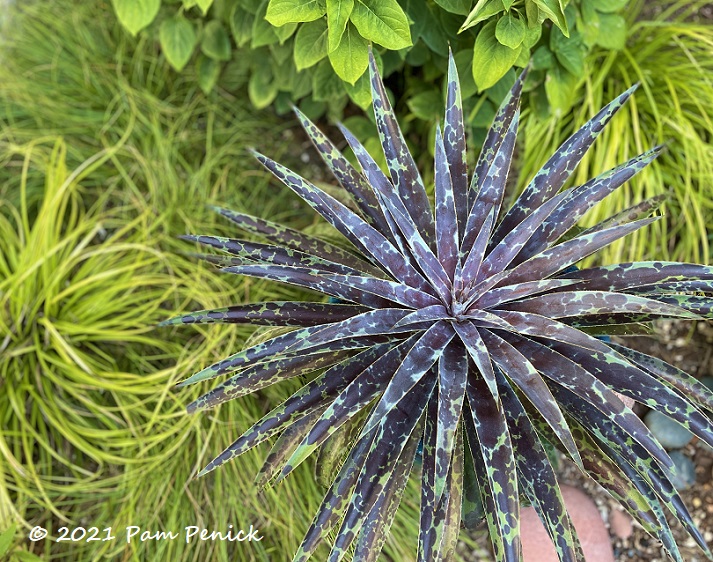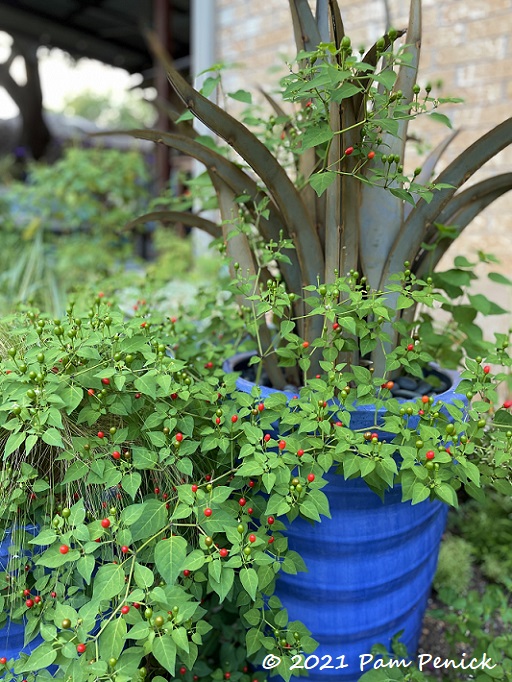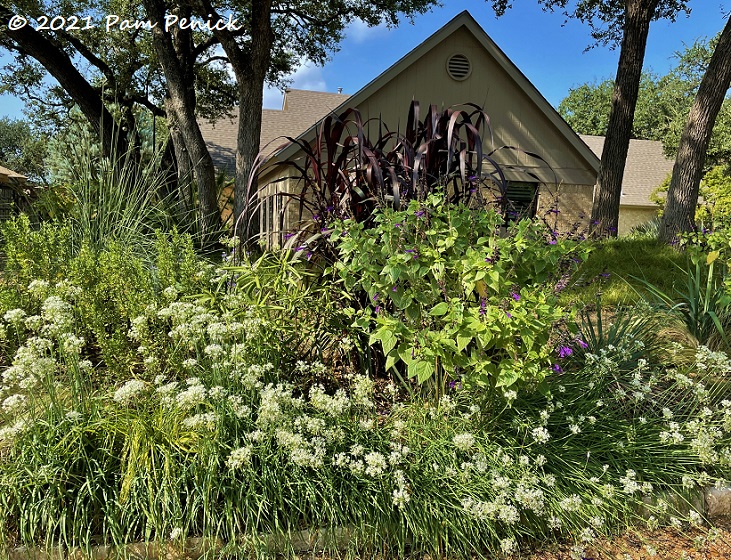Moonglow mangave and signs of summer’s end

I’m a little infatuated with mangaves, those succulent-leaved hybrids of agaves and manfredas. I’ve been growing a couple hardy mangaves (hardy most winters in our zone 8b) for years as focal points in protected beds or containers. My hardy faves are ‘Macho Mocha’ and its variegated counterpart, ‘Espresso’. I also like petite ‘Bloodspot’ mangave, which I grow in pots that I protect during freezes.
I’d be a mangave collector if I lived in a frost-free climate or had a greenhouse to stash them in winter. But I usually just try a new one every year or so, in a container I leave out all year, until a hard freeze gets it. ‘Pineapple Express’ lasted a few years, occasionally dying back to the roots but coming back quickly. Last year I grew ‘Spotty Dotty’, and it made it all winter until the epic February freeze.
Now I’m growing a new one, ‘Moonglow’, which may be my favorite yet. Just look at those elegant, narrow, starburst leaves splotched with eggplant purple and seafoam green! Beautiful. I’m growing it in a blue pot in a partly shady bed with Philippine violet and chartreuse ‘Everillo’ sedge, another favorite for my dry shade garden.

In the same bed, native chile pequin (Capsicum annuum) is coming on strong, its little round berries reddening up. Every August and into September, I eagerly watch for signs of summer’s end. Chile pequin ripening is one. American beautyberry berries turning purple is another.

Flowering garlic chives (Allium tuberosum) is another harbinger of summer’s end. Oh and I just saw a couple little oxblood lily snouts poking up. All they need is one good rain to burst into bloom and herald the waning of the Death Star. I can’t wait.
__________________________
Digging Deeper
Need design help with your yard? Hire me as your personal garden coach! Maybe you need replacement plant ideas after the big freeze. Or maybe your landscaping has grown tired, and you want fresh curb appeal. Or perhaps you’re ready to get rid of some lawn and create a pollinator garden, bird habitat, or hangout space for you and your friends. I’m here to help! Contact me to let me know what’s going on, and let’s figure it out together. My range is Austin and suburbs within a 25-min. drive of NW Austin, but I’m flexible and can travel farther with a surcharge, so let me know where you are. Weekday morning appts. only.
Come learn about gardening and design at Garden Spark! I organize in-person talks by inspiring designers, landscape architects, authors, and gardeners a few times a year in Austin. These are limited-attendance events that sell out quickly, so join the Garden Spark email list to be notified in advance; simply click this link and ask to be added. Season 8 kicks off in fall 2024. Stay tuned for more info!
All material © 2025 by Pam Penick for Digging. Unauthorized reproduction prohibited.


I share your eagerness to see the end of the summer season, although other than a change in the light there are few signs of it here as yet. I also share your enthusiasm for Mangaves. I haven’t even tried to count how many I’ve accumulated – and I’m grateful I don’t have to worry about protecting them from freezes.
I’m jealous, Kris! There are so many beautiful ones nowadays. I’d love to grow more.
I like the mottling on the Mangave. I too am ready for fall. The Ash Tree seeds are descending. That is a sure sign that fall is moving in. Hard to believe when we are to have some 90 degree days this coming week.
I hope your heat wave is brief, Lisa. And now you’ve got me wondering what it’s like to see ash tree seeds coming down.
Hi Pam,
I am wondering what is the plant in the blue pot, just behind the chile pequin? It looks like an iron plant-like ornament but it could also be a very dwarf form of Phormium tenax, once seen in NZ and never more again. Nice thing anyway, and surely good to marry with mangaves!
It’s a steel agave. 🙂 It replaced a plant that was killed by the February freeze, and the chile pequin has grown up through it like a trellis.